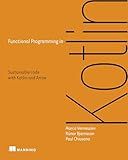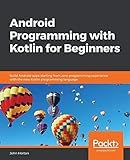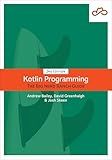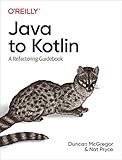Best Kotlin Programming Guides to Buy in December 2025

Kotlin in Action, Second Edition



Kotlin In-Depth: A Guide to a Multipurpose Programming Language for Server-Side, Front-End, Android, and Multiplatform Mobile (English Edition)



Kotlin Programming: Learning Guide Covering the Essentials and Advancing to Complex Concepts



How to Build Android Applications with Kotlin: A hands-on guide to developing, testing, and publishing production-grade Android 16 apps



Functional Programming in Kotlin



Android Programming with Kotlin for Beginners: Build Android apps starting from zero programming experience with the new Kotlin programming language



Kotlin Programming: The Big Nerd Ranch Guide



Java to Kotlin: A Refactoring Guidebook


In Kotlin, you can iterate two lists in parallel using the zip function or a simple for loop. Here's how you can do it:
- Using the zip function: The zip function combines the elements of two lists into pairs, allowing you to iterate over them simultaneously. Iterate over the combined pairs using a for loop or any other method. Example: val list1 = listOf("A", "B", "C") val list2 = listOf(1, 2, 3) val combinedPairs = list1.zip(list2) for (pair in combinedPairs) { val elementFromList1 = pair.first val elementFromList2 = pair.second // Perform your operations here }
- Using a for loop: Iterate over the indices of one of the lists using the indices property. Access the elements of both lists using the current index. Example: val list1 = listOf("A", "B", "C") val list2 = listOf(1, 2, 3) for (index in list1.indices) { val elementFromList1 = list1[index] val elementFromList2 = list2[index] // Perform your operations here }
These methods allow you to traverse and operate on two lists in parallel, accessing corresponding elements at each iteration.
What are the common use cases for parallel iteration in Kotlin?
There are several common use cases for parallel iteration in Kotlin:
- Performing concurrent operations on a collection: Parallel iteration allows you to execute operations on different elements of a collection simultaneously, which can help improve the overall performance of your code. For example, if you have a large collection of data, you can use parallel iteration to process the data in parallel, thereby reducing the overall processing time.
- Parallel processing of independent tasks: If you have multiple independent tasks that you want to execute in parallel, you can use parallel iteration to process each task concurrently. This can be useful, for example, when processing multiple files or communicating with multiple external services simultaneously.
- Parallelizing computations: In scenarios where you need to perform heavy computations, parallel iteration can be used to distribute the workload across multiple threads. By splitting the computation among different threads, you can take advantage of multi-core processors and speed up the processing time.
- Concurrent data processing: If you have a shared data structure that needs to be processed by multiple threads concurrently, parallel iteration allows you to access and modify the data in a thread-safe manner. This can be useful, for example, when processing data from multiple input sources, such as multiple network streams or multiple database connections.
- Exploiting parallel algorithms: Parallel iteration can be used to implement parallel algorithms, such as parallel sorting or searching algorithms, that can leverage multiple threads to speed up their execution time. This can be particularly beneficial for handling large datasets or performing computationally intensive tasks.
Overall, parallel iteration in Kotlin provides a way to distribute workload and execute tasks concurrently, thereby improving performance and leveraging the capabilities of modern multi-core processors.
How to perform a specific operation on each pair of elements in two lists using parallel iteration?
To perform a specific operation on each pair of elements in two lists using parallel iteration, you can use the zip() function in Python. Here's an example:
list_1 = [1, 2, 3, 4] list_2 = [5, 6, 7, 8]
Perform addition on each pair of elements
result = [x + y for x, y in zip(list_1, list_2)] print(result)
Output:
[6, 8, 10, 12]
In this example, zip(list_1, list_2) creates an iterator that returns a tuple of the corresponding elements from both lists. Then, using a list comprehension, we perform the addition operation on each pair of elements with x + y. The final result is a list [6, 8, 10, 12].
How to handle uneven distribution of load during parallel iteration in Kotlin?
In Kotlin, the parallel iteration can be achieved using the forEach function provided by the List or Array class. However, if you encounter an uneven distribution of load, you can consider using the withIndex function along with the split function to divide the workload evenly among the threads. Here's an example:
import kotlin.concurrent.thread
fun main() { val list = listOf(1, 2, 3, 4, 5, 6, 7, 8, 9, 10) val threadCount = Runtime.getRuntime().availableProcessors()
val chunks = list.withIndex().split(threadCount)
val threads = mutableListOf<Thread>()
chunks.forEach { chunk ->
val thread = thread {
chunk.forEach { (index, value) ->
// Perform the desired operation on each element
println("Thread: ${Thread.currentThread()} | Index: $index | Value: $value")
}
}
threads.add(thread)
}
threads.forEach { it.join() } // Wait for all threads to complete
}
fun List.split(parts: Int): List<List> { val size = size val chunkSize = size / parts val remainder = size % parts
var currentIndex = 0
return List(parts) { index ->
val endIndex = currentIndex + chunkSize + if (index < remainder) 1 else 0
val chunk = subList(currentIndex, endIndex)
currentIndex = endIndex
chunk
}
}
In this example, list represents the collection you want to iterate over. The chunk variable represents an evenly divided portion of the collection assigned to each thread. The split function splits the list into threadCount number of parts.
Within the forEach loop, a new thread is created for each chunk. Each thread then iterates over its assigned chunk and performs the desired operation.
Finally, the main thread waits for all worker threads to complete by calling join() on each thread.
This approach helps distribute the load evenly among threads, ensuring that the work is divided efficiently.
